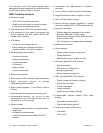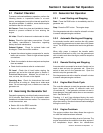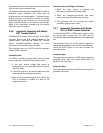
TP-6804 12/11 21Section 2 Generator Set Operation
Section 2 Generator Set Operation
2.1 Prestart Checklist
To ensure continued satisfactory operation, perform the
following checks or inspections before or at each
startup, as designated, and at the intervals specified in
the service schedule. In addition, some checks require
verification after the unit starts.
Air Cleaner. Check for a clean and installed air cleaner
element to prevent unfiltered air from entering the
engine.
Air Inlets. Check for clean and unobstructed air inlets.
Battery. Check for tight battery connections. Consult
the battery manufacturer’s instructions regarding
battery care and maintenance.
Exhaust System. Check for exhaust leaks and
blockages. Check the muffler condition.
D Inspect the exhaust system components for cracks,
leaks, and corrosion. Check for tight exhaust system
connections.
D Check for corroded or broken metal parts and replace
them as needed.
D Check that the exhaust outlet is unobstructed.
Oil Level. Check the oil level before starting the
generator set and at the intervals given in Section 5,
Scheduled Maintenance. Maintain the oil level at or
near, not over, the full mark on the dipstick.
Operating Area. Check for obstructions that could
block the flow of cooling air. Keep the air intake area
clean. Do not leave rags, tools, or debris on or near the
generator set.
2.2 Exercising the Generator Set
Operate the generator set without load once each week
for 20 minutes. See Section 2.4 for information about
loaded and unloaded exercise modes. For instructions
to set the exerciser, see:
D Section 3.6 for the RDC2 controller
D Section 4.5 for the DC2 controller
2.3 Generator Set Operation
2.3.1 Local Starting and Stopping
Start: Press the RUN button to immediately start the
generator set.
Stop: Press the OFF button. The engine stops.
Run the generator set with no load for at least 2 minutes
to ensure adequate engine cooldown.
2.3.2 Automatic Starting and Stopping
An automatic transfer switch monitors the utility power
and signals the generator set to start when utility power
is lost. The ATS then transfers the load to the generator
set.
When utility power is restored, the transfer switch
transfers the load back to utility, runs the generator set
with no load to cool down the engine, and then stops the
generator set.
2.3.3 Remote Starting and Stopping
A remote switch connected to terminals 3 and 4 can be
used to start and stop the generator set. Close the
switch to start and run the generator set. Open the
switch to stop the generator set.
Run the generator set with no load for at least 2 minutes
to ensure adequate engine cooldown.
2.3.4 Engine Start Crank Cycle
The controller attempts to start the generator set three
times (three crank cycles, 15 seconds crank and
15 seconds off). If the generator set does not start in
three attempts, the system shuts down on an overcrank
fault. See Section 2.5.
Cranking 1, 2, and 3 are displayed during the crank
cycle. Pressing the OFF button during the crank cycle
stops the cranking. No other buttons are acknowledged
during the crank cycle.
2.3.5 Engine Cooldown
The engine cooldown time delay allows the engine to
run after the loads have been removed.
The engine cooldown time delay is set to 5 minutes. The
engine stops before the cooldown time delay expires if
the temperature drops below the cooled-down


















